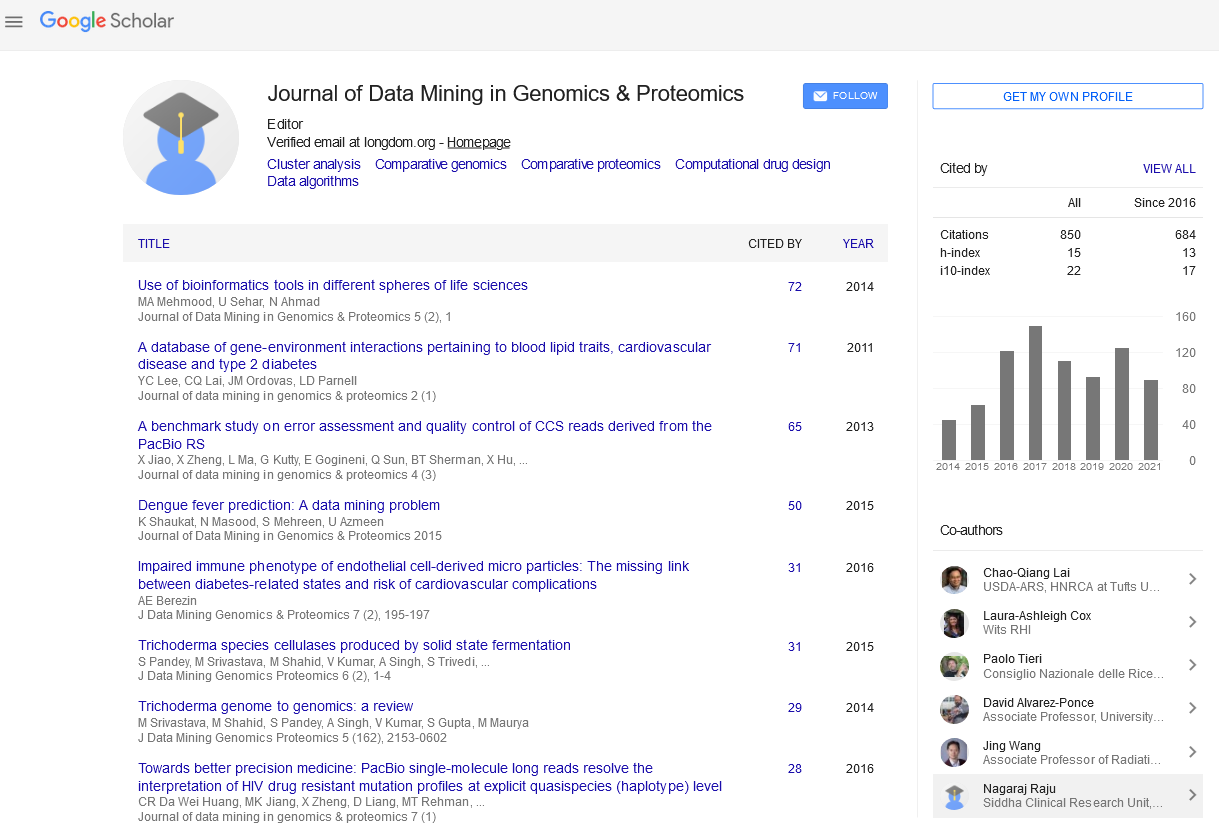PMC/PubMed Indexed Articles
Indexed In
- Academic Journals Database
- Open J Gate
- Genamics JournalSeek
- JournalTOCs
- ResearchBible
- Ulrich's Periodicals Directory
- Electronic Journals Library
- RefSeek
- Hamdard University
- EBSCO A-Z
- OCLC- WorldCat
- Scholarsteer
- SWB online catalog
- Virtual Library of Biology (vifabio)
- Publons
- MIAR
- Geneva Foundation for Medical Education and Research
- Euro Pub
- Google Scholar
Useful Links
Share This Page
Journal Flyer

Open Access Journals
- Agri and Aquaculture
- Biochemistry
- Bioinformatics & Systems Biology
- Business & Management
- Chemistry
- Clinical Sciences
- Engineering
- Food & Nutrition
- General Science
- Genetics & Molecular Biology
- Immunology & Microbiology
- Medical Sciences
- Neuroscience & Psychology
- Nursing & Health Care
- Pharmaceutical Sciences
Regulatory mechanisms of active genome repair
2nd International Conference on Big Data Analysis and Data Mining
November 30-December 01, 2015 San Antonio, USA
Sukesh R. Bhaumik
Southern Illinois University, USA
Posters-Accepted Abstracts: J Data Mining Genomics Proteomics
Abstract:
Genomic DNA is continuously challenged by a number of damaging agents. Nucleotide excision repair (NER) removes a wide variety of DNA lesions from active and inactive genes. NER has been classified into two types, namely global genomic (GG) and transcription-coupled (TC) NER. The lesions in transcriptionally inactive or silent areas of the genome are repaired by GG-NER, while TC-NER removes lesions from the coding sequence of active gene. Both subpathways of NER are fundamentally identical except their mechanisms of damage recognition. The damage recognition step has been implicated in differential kinetics of these two repair processes. TC-NER functions at a much faster rate than GG-NER, as damage is quickly recognized in TC-NER. However, how the DNA lesion is promptly recognized in TC-NER is not clearly understood in vivo. To address this important question, we performed a series of experiments in yeast using 4-nitroquinoline-1-oxide as a DNA damaging agent. We find that the DNA lesion recognition factor in TC-NER, Rad26p (homologue of human CSB), is recruited to the coding sequences of active genes in response to DNA damage with the help of elongating RNA polymerase II. However, Rad26p does not recognize DNA lesions in the absence of elongating RNA polymerase II or active transcription. Subsequent to the recruitment of Rad26p to the site of DNA lesion, elongating RNA polymerase II is disassembled through the degradation of its largest subunit, thus facilitating other DNA repair factors to access the lesion through Rad26p for repair. Further, Rad26p plays an important role to alter the chromatin structure to facilitate transcription as well as repair. Together, these results provide an important insight as to how Rad26p is delivered to the damage sites at active, but not inactive, genes to stimulate repair in vivo, thus shedding much light on the damage recognition and repair at active genes to maintain normal transcription in living eukaryotic cells. Next, we analyzed whether like NER, the repair of very toxic DNA double-strand break (DSB) is also coupled to transcription. Intriguingly, our data revealed a preferential DNA DSB repair at the active gene, thus supporting the existence of transcription-coupled DSB repair.
Biography :
Sukesh R. Bhaumik has completed his Ph.D. from Tata Institute of Fundamental Research, India, and postdoctoral studies from the University of Massachussetts Medical School, USA. He is currently an Associate Professor in the Department of Biochemistry and Molecular Biology at Southern Illinois University School of Medicine, USA. His current research is focused on regulation of eukaryotic gene expression and active genome integrity. He has published more than 50 papers in reputed journals.


